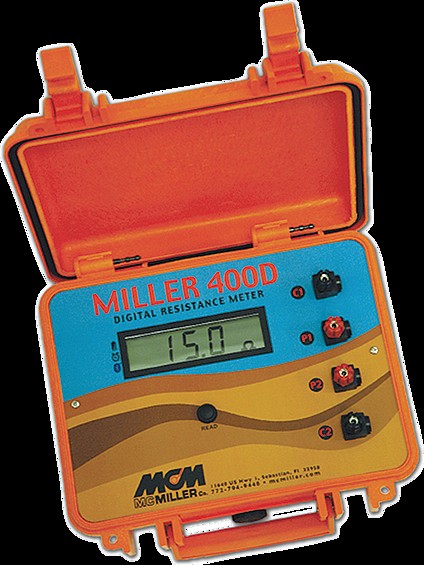When combined with appropriate electrodes (pins) and test leads, the H-4385D Resistivity meter can be used to measure earth resistance with the push of a button. There is no need to adjust dials or select ranges; the H-4385D Resistivity Meter automatically provides a direct resistancereading.
In addition to taking (and recording) readings manually, a wireless computer (PDA, laptop etc.) can be programmed to acquire resistance readings directly from the H-4385D, since the resistance meter has a built-in wireless interface. In the latter case, the PDA or PC, which is in control of the wireless link, commands the H-4385D to take a reading and the resistance value is sent automatically to the PDA orPC.
Depending on the application, 4-Electrode, 3-Electrode or 2-Electrode, the MILLER-400D can be used to determine thefollowing:
The average earth resistivity to a specific depth (with the application of an appropriate multiplier to convert resistance to resistivity, based on the electrode separation distance) 4-ElectrodeApplication
The resistivity of a soil sample, or of a liquid, via an electrolyte (soil/liquid) box (with the application of an appropriate multiplier to convert resistance to resistivity, depending on the box geometry) 4-ElectrodeApplication
The resistance-to-earth of a buried electrode, such as a ground rod, or an anode, for example 3-ElectrodeApplication
The resistance between two buried electrodes, such as two ground rods, or two anodes 2-ElectrodeApplication
All H-4385D resistivity meters include a calibrationcertificate
The H-4385D resistivity meter has a resistance measurement range (with automatic ranging) from 0.01? to 10M?. Over the range, 0.01? to 1M?, the specified meter accuracy is 1.6% 1 LS display digit 0.01? and over the range, 1M? to 10M?, the specified accuracy is 5% 1 LS display digit. Note: For load resistances >1M?, in addition to internal meter errors, errors associated with test lead proximity can also be significant. It should be noted, however, that these accuracy specifications assume a low electrode (pin)/earth contact resistance during the measurement. In this regard, it is recommended that the electrodes (pins) be firmly driven into the earth (pins cannot be loose) and, in dry soils, it is recommended that the soil around the pins be moistened in order that reliable (low resistance) contact be made to the surroundingsoil.
The voltage source inside the H-4385 resistivity meter that supplies the current used in the resistance measurement is a 12V(rms) crystal-controlled 82.2Hz square wave oscillator and the internal ammeter and voltmeter use very narrow band-pass filters centered at 82.2Hz. What this means is that resistance measurements are unaffected by any stray interference signals (having frequencies other than 82.2Hz) that may be present in the earth during themeasurement.
The H-4385D resistivity meter runs on a set of replaceable D-size alkaline batteries, so there is no requirement to periodically recharge the unit or to plug the unit into a power source. Furthermore, due to its extremely low power consumption design, the H-4385D can perform 10,000 single resistance readings, for example, on a fresh set ofbatteries.
NEW: A configuration application is now available for Android tablets. It is included on the CD that ships with the H-4385D. If you already own a H-4385D, you can
download the applicationhere
.
MS Windows based software can be downloadedhere:
H-4385D Setup:
H-4385D Configuration:
